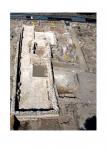Summary (English)
The 2015 campaign concentrated on investigations linked to the forthcoming publication of the Small Baths, with the aim of obtaining results that would help trace this building’s long life, which began with its construction in the Severan period. Its structures remained in use with various functions until at least the 7th century A.D.
Many questions remained to be answered about the first building and the restructuring of the baths, as Pesce’s excavations left very little documentation. However, it was seen that the building did not collapse but was continually robbed although several rooms continued to be used, both as residential spaces and as areas occupied by modest craft-working activities.
Two adjacent rooms on the via del porto, which did not appear to present any evidence of a particular function, were investigated.The south room has always been part of the baths. In phase I, it was an area surrounded by a portico, of which the squared blocks interpretable as column bases were present in the north-east and south-west corners. In phase II, at a higher level, a sewer was built which led to the almost complete removal of the earlier paving. Following the sewer construction, a beaten mortar surface was laid over a substantial make up, on which the two steps constituting the monumental alteration to the entrance were built. Interventions, some recent, have damaged the complex making any clear interpretation difficult.
The north room was a continuation of the portico, which was interrupted by the construction of the two walls to the east and west. Clearly abutting the walls of the tepidarium, they represent a late restructuring, when the warm room had lost its original function. It was possible to identify the layers of dumped soil into which these two structures were cut and therefore it is hoped that the study of the materials recovered from the layers will suggest a date for the foundations.
The aim of the 2015 campaign was the complete excavation of the praefurnium room. Here, a floor surface relating to the main function of this zone was identified. Evidence of a series of rebuilds was also clear. These resulted in the raising of the mouth of the praefurnium: in this case too it also difficult to get an absolute chronology due to the lack of data from the earlier excavations.
A square hole (1 m2), was excavated to the south of the praefurnium opening. It contained ash and various archaeological materials and was interpreted as a structure relating to maintaining and feeding the fire (cf. bath building at San Giovanni Incarico-Frosinone). It was also seen that the praefurnium was built on a thick layer of dumped earth, obliterating and razing an imposing wall on an east-west alignment. The threshold to the room was built on a part of this wall.
- Bianca Maria Giannattasio
Director
- Bianca Maria Giannattasio - Università degli Studi di Genova
- Marco Minoja - Soprintendenza per i Beni Archeologici per le province di Cagliari e Oristano
- Maurizia Canepa - Soprintendenza dei beni archeologici per le province di Cagliari e Oristano
Team
- Bianca Maria Giannattasio - Università degli Studi di Genova
- A. Parodi - Università degli Studi di Genova
- S. Magliani- Università degli Studi di Genova
- Valentina Cosentino
Research Body
- Università degli Studi di Genova, Dipartimento Antichità, Filosofia, Storia (D.A.FI.ST.)
Funding Body
- Università degli Studi di Genova






![Download [PDF]](/excavation/skins/fasti/images/results/download_sml.png)